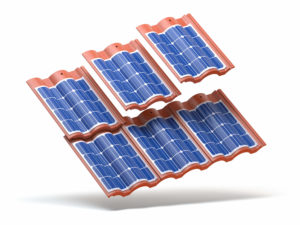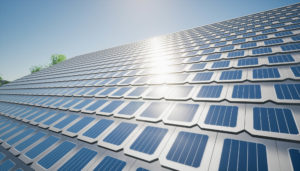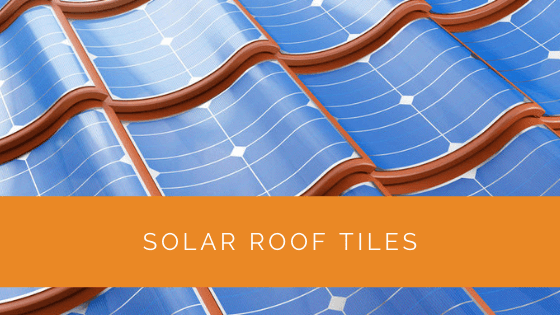Are you tired of the sight of bulky solar panels on your roof? Are you looking for a more stylish and sustainable solution for your energy needs? Look no further than solar roof tiles! These innovative tiles are not only a cutting-edge technology for harnessing the power of the sun but also a sleek and stylish addition to your home’s exterior.
Also known as solar shingles or solar slates, these tiles are designed to blend seamlessly into your roof, creating a clean and modern look. But their benefits go beyond aesthetics – solar roof tiles are also highly efficient and eco-friendly, making them a smart choice for homeowners looking to reduce their carbon footprint and save on energy costs. In this article, we’ll explore the exciting possibilities of solar roof tiles, including their advantages and disadvantages and how they compare to traditional solar panels. So join us on this journey to discover the exciting world of solar roofing solutions and take the first step towards a greener, more sustainable future for your home.
Contents
- 1 Key Takeaways
- 2 What Are Solar Roof Tiles?
- 3 Options Available While Installing Solar Roof Tiles
- 4 Why Should You Invest in Solar Tiles?
- 5 Disadvantages of Solar Roof Tiles
- 6 Solar Panels vs. solar Shingles
- 7 Case Study: Integrating Solar Roof Tiles in a Modern Home
- 8 Expert Insights From Our Solar Panel Installers About Solar Roof Tiles
- 9 Discover the Power of Solar with Solar Panels Network
- 10 Bottomline
Key Takeaways
- Solar roof tiles, also known as solar shingles or slates, offer a sleek and aesthetically pleasing alternative to traditional solar panels while generating renewable energy.
- Options for installing solar roof tiles include on-roof tiles, in-roof tiles, and complete solar roofs, each with advantages and considerations.
- Advantages of solar tiles include a sleek appearance, high durability, and suitability for listed buildings. Still, they come with a higher cost, lower efficiency, complex installation, and limited availability compared to traditional solar panels.
What Are Solar Roof Tiles?
Solar roof tiles are also referred to as solar shingles or solar slates and are used as a replacement for traditional solar panels. These tiles are made with small solar panels with photovoltaic cells that absorb sunlight as conventional panels.
This energy output is converted into DC (Direct Current) form. Further, a solar inverter helps produce AC (Alternating Current) output and can be connected via electrical cables to a battery to store excess electricity generated.
In other words, we can say that solar roof tiles are just a modernised version of traditional panels with multiple shingles closely connected in an array. However, one significant difference is that installing solar tiles will not alter your existing roof’s appearance.
Options Available While Installing Solar Roof Tiles
Switching from a regular to a solar roof tile will undoubtedly be a smart investment. You can escape the hassle of paying the electricity bill and contribute to the green energy movement. Here are a few options you can decide on.
On-Roof Tiles
A common occurrence in UK installations is that on-roof tiles are fixed on the mounts already on your roof space. There is no need for roof replacement here, as you add an element on the top of non-solar tiles on the current roof. These tiles are less evident than the standard solar panels.

In-Roof Tiles
A selected portion of the existing roof structure is replaced with solar tiles. Some of the traditional roof tiles are replaced with photovoltaic roof tiles. As the integration process is on the level with the entire roof, this solar tile installation would appear more subtle than the on-roof one.
Complete Solar Roof
If you want to step towards being a solar-powered home, solar roofs will work best. Instead of a specific portion, the entire roof is replaced with an intelligent combination of regular and solar tiles. It will help keep your roof structure safe and ultimately offer the facility to generate electricity per your requirements.
Why Should You Invest in Solar Tiles?
Are you planning to go solar but not convinced about solar tiles? In that case, read through the below-mentioned advantages that might help change your mind.
Sleek Appearance
Undoubtedly, one of the reasons people tend to avoid the installation of solar panels is the way they look. But with solar tiles, there is no such ‘eyesore’ factor. Slate roofs look like other traditional roofs and do not appear very bulky. As a result, your house’s aesthetic appeal stays intact.
High Durability
It doesn’t take much to see a crack in a traditional tile. If you live in a geographical region where hailstorms or snowstorms are regular, you have probably called the builder too often.
But solar tiles are designed to be about three times stronger and effectively protect your home against leaky roofs. As a result, your roof is set to last for decades to come. Also, most manufacturers offer a good warranty duration.
Fitting for Listed Buildings
Listed buildings are located in conservation areas where homeowners are not legally allowed to put up solar panels as it can spoil the appearance of your property. But with solar roof tiles, there are no such limitations.
You can easily integrate solar tiles on your roof without causing any damage to the house structure and conservation area guidelines.
Disadvantages of Solar Roof Tiles
With the above-listed advantages, there are a few notable disadvantages of picking solar tiles over solar panels.
Very Costly
Switching to solar tiles is quite a good option for the stylish appearance of your home. But it is bound to cost you almost twice the amount you would pay for solar panels. For example, you could go solar for 3 kW with panels for around £4,000-£6,000.
But with roof tiles, you are looking at an expenditure of £10,000-£12,000. On average, solar roof tiles cost £16.71 per square foot. This factor can deter many people if aesthetics is not their top-shelf priority.
Poor Efficiency
Solar panels are known for their superior efficiency of about 18% – 25%. More efficiency implies that the panel can convert more solar energy into electricity.
But with roof tiles, you only get an 8% – 15% efficiency range. It means that you will end up paying more instead of saving money.
Limited Compatibility
Solar roof tile installation is not as easy as it sounds. To cover up the energy required for your household, you might need to cover the entire roof surface with solar slates.
You could even be asked to get a new roof for some buildings altogether. It is inconvenient if you are too attached to your home or not ready to hire a full-time construction worker.

Complex Installation Process
Conventionally, solar panels are installed within a few days and do not require an army of workers up on your roof. But this is not quite the situation with solar roof tiles.
You might need a complete roof replacement based on your pre-existing roof structure. In the past, solar roof installation has been known to take over a fortnight with around 10-15 people on the job.
Less Availability
Roof tiles are still a relatively newer concept. Not many companies have ventured into this domain with crucial issues like installation, cost, and efficiency. As a result, the market is still in its beginner stage with fewer competitors.
It implies that the customer has limited choices to pick from. But with the ever-escalating developments in the field of solar technology, there are bound to be more options in future.
Solar Panels vs. solar Shingles
Even though the working principle of solar tiles and shingles is similar, there are still some differences.
Size
An average solar panel measures around 40 inches wide and 66 inches long. On the other hand, shingles are nearly 12 inches wide and 86 inches long.
Panels weigh about 42 pounds, while shingles only weigh 13 pounds. Also, a roof tile’s thickness is less than an inch.
Material
Solar panels are made up of silicon. However, solar roof tiles are made with CIGS (Copper Indium Gallium Selenide) semiconductors.
This particular material allows for a thin structure and more surface flexibility. Some companies also utilise the naturally occurring Monocrystalline Silicon (Mono-Si) semiconductor.
Output
Solar panels are available for different wattage ranges. On average, you will find that panels are available from 225 to 350 watts.
Shingles have a comparatively lower power output of around 13 to 63 watts. However, 350 PV tiles can effectively produce about 40 to 70% of your electricity.
Case Study: Integrating Solar Roof Tiles in a Modern Home
Background
At Solar Panels Network, we recently had the opportunity to work with a homeowner who wanted to integrate renewable energy solutions without compromising the visual appeal of their modern home. The client was particularly interested in solar roof tiles as they sought a stylish, eco-friendly option that blended seamlessly with their home’s design.
Project Overview
The project aimed to install a solar roof tile system that would not only meet the homeowner’s energy needs but also enhance the property’s aesthetic value. The client desired a solution that was efficient, durable, and visually unobtrusive. The choice was between on-roof tiles, in-roof tiles, and a complete solar roof.
Implementation
- Initial Assessment: Our team conducted a thorough site evaluation to determine the roof’s suitability for solar tile installation. We assessed the existing roof structure and identified the best areas for maximum sunlight exposure.
- Tile Selection: The client chose high-quality monocrystalline silicon solar tiles known for their efficiency and durability. This decision was based on the roof’s orientation and the client’s energy consumption requirements.
- Installation Process:
- Preparation: Our installation team prepared the roof by removing the existing tiles in the designated areas.
- Tile Placement: We installed the solar tiles, ensuring they were seamlessly integrated with the remaining roof structure.
- Electrical Integration: The tiles were connected to an inverter system, converting the generated DC into usable AC power for the household.
- System Testing and Handover: After installation, we thoroughly tested the system to ensure optimal performance. We provided the client with a detailed guide on monitoring and maintaining the system.
Results
- Energy Production: The installed system exceeded the client’s expectations, generating approximately 70% of the household’s electricity needs. This performance aligns with the tiles’ efficiency range of 8-15%.
- Aesthetic Integration: The client was particularly pleased with the sleek, modern look of the solar roof tiles, which complemented their home’s contemporary design.
- Cost Efficiency: While the initial installation cost was higher than traditional panels, the long-term savings on electricity bills and the added property value were significant benefits.
- Durability and Maintenance: The solar tiles proved to be highly durable, requiring minimal maintenance. The client appreciated the robust construction, especially given the variable weather conditions.
Summary
This project highlighted the versatility and appeal of solar roof tiles for homeowners prioritising both aesthetics and energy efficiency. While the initial investment was higher, the long-term benefits in energy savings, property value, and environmental impact made it a worthwhile choice. At Solar Panels Network, we believe that such installations pave the way for more sustainable and visually appealing renewable energy solutions.
Expert Insights From Our Solar Panel Installers About Solar Roof Tiles
Solar roof tiles are an excellent choice for homeowners who want to maintain the aesthetic appeal of their property while still benefiting from renewable energy. They’re perfect for those who find traditional panels bulky or unattractive.
Senior Solar Installer
While solar roof tiles might have a higher upfront cost, they offer unique advantages, especially for listed buildings or those in conservation areas where maintaining the architectural integrity is crucial.
Renewable Energy Consultant
The installation process for solar roof tiles is more complex than traditional panels, but the end result is a seamless integration with the roof that looks like standard roofing material. It’s a great option for those willing to invest in the aesthetic and energy benefits.
Lead Solar Technician
Discover the Power of Solar with Solar Panels Network
Are you navigating the world of solar installations? Look no further than Solar Panels Network, the UK’s trusted partner in harnessing the sun’s potential. Our dedication goes beyond just installations; we’re on a mission to transform how homeowners and businesses across the UK perceive and utilise energy. By choosing us, you’re reducing your carbon footprint and making a smart financial move that promises savings for years ahead. Contact us today and embark on your solar journey.
Bottomline
The hype around roof tiles in the solar industry is steadily increasing with time. With benefits like sleek appearance and elimination of electricity bills, it sure seems like a good project to consider for your homes or offices.
If you are unsure whether to buy solar roof tiles, go through our guide for clarity.
Even though solar tiles work just like panels, there are still some notable differences between both options. You can choose between both based on your roof structure, budget, and energy requirements.
About the Author
Solar Panels Network stands at the forefront of solar energy solutions, driven by a team of seasoned solar engineers and energy consultants. With over decades of experience in delivering high-quality solar installations and maintenance, we are committed to promoting sustainable energy through customer-centric, tailored solutions. Our articles reflect this commitment, crafted collaboratively by experts to provide accurate, up-to-date insights into solar technology, ensuring our readers are well-informed and empowered in their solar energy decisions.

